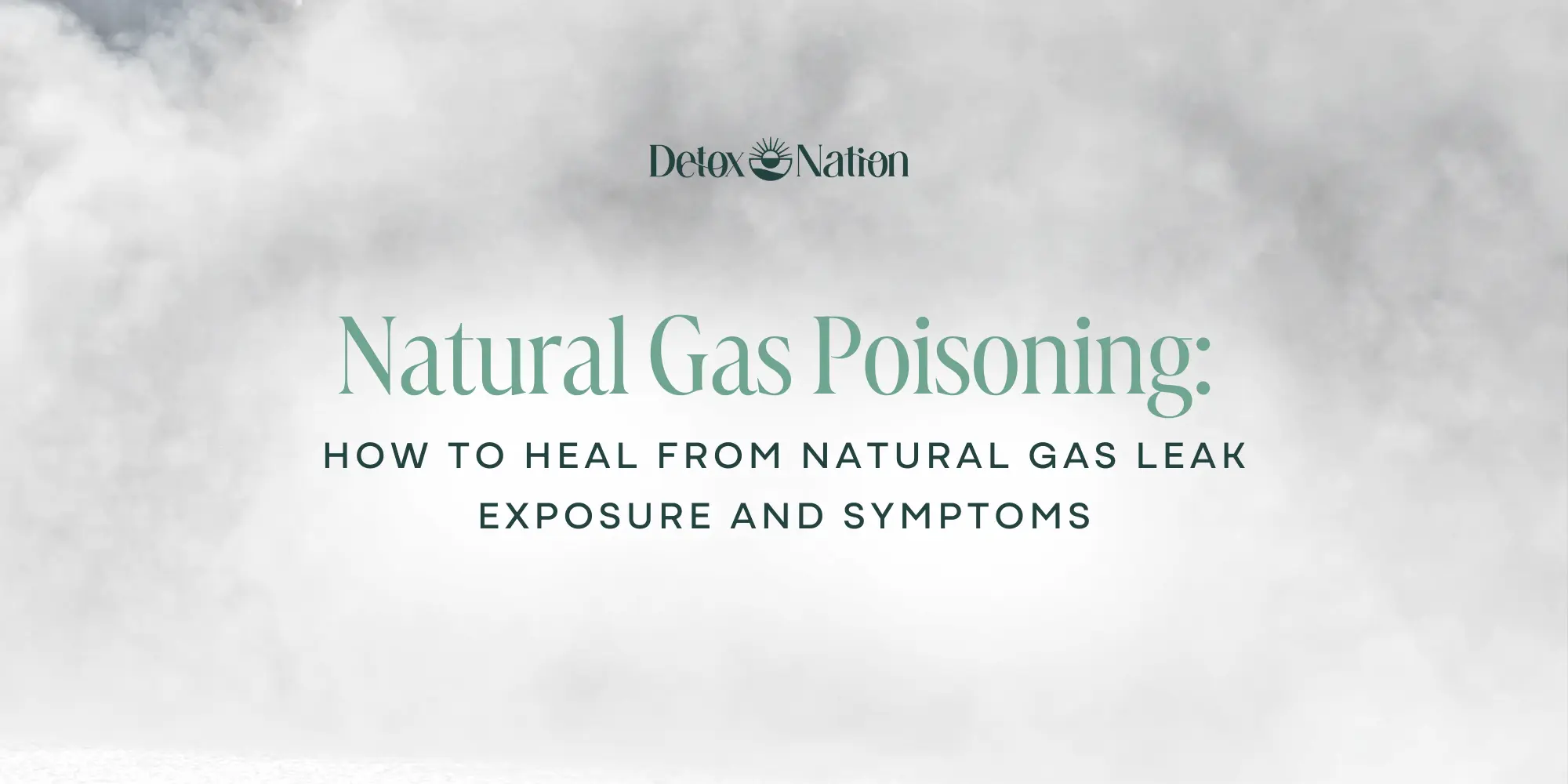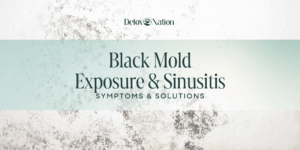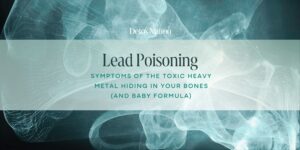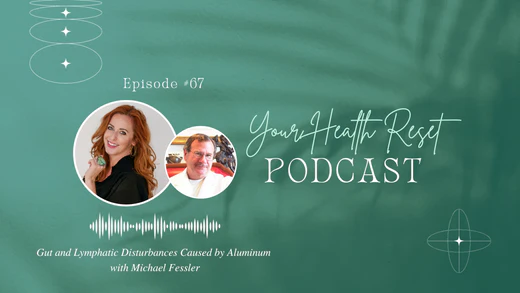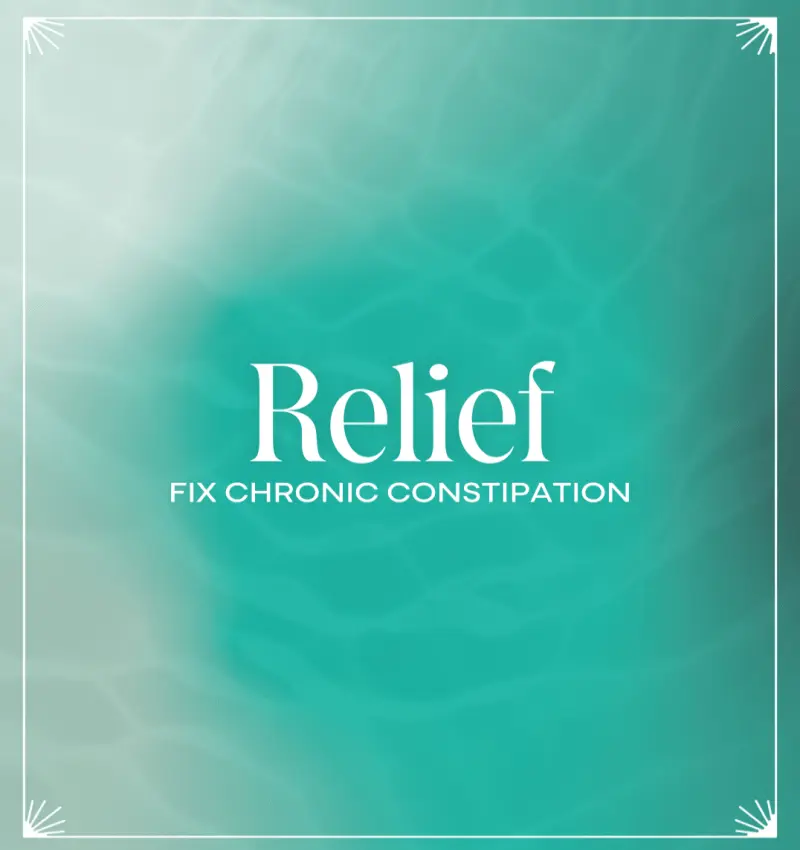Think you’d smell a natural gas leak? Think again. Chronic signs and symptoms of exposure, like fatigue, brain fog, and respiratory issues could be signs of natural gas poisoning — even without that “rotten egg” smell.
Let’s talk about a common source of toxicity that’s hiding in plain sight—right under your nose.
Literally.
We’ve had two recent clients whose health spiraled thanks to slow, silent gas leaks in their homes.
One had a heater leak just beneath their bedroom—yes, the room where your body is supposed to heal—while the other had a steady leak from the kitchen stove.
Both showed “off the charts” chemical exposure in their Tox Lab panels, and both had been told for years that their symptoms were “just stress.”
And then there was the chef who worked for decades in poorly ventilated kitchens, surrounded by open flames and exhaust that no one thought twice about.
His labs were sky-high in volatile organic compounds (VOCs) associated with natural gas combustion.
By the time cancer showed up, his labs were loaded with combustion byproducts—chemicals his body had no way of clearing on its own.
Natural gas might seem “clean” on your utility bill. But inside the body, the story is very different.
In this article, I’m going to walk you through:
- The toxins involved
- What natural gas really does to your body
- How to check your home for gas leaks (without getting gaslit)
- And most importantly: how to detox and reclaim your vitality

What Is Natural Gas — And Why Is It in Your House?
Up to half of all households in the US use natural gas (1, 6).
If you grew up thinking natural gas was “clean energy,” you’re not alone.
It’s been marketed that way for decades — as the smarter, safer, more affordable way to cook your food, heat your shower, and keep your house cozy.
And to be fair, that gas flame does make a mean stir-fry.
But here’s what that glowing blue flame doesn’t show you: What’s actually in the gas. (And what it’s doing to your body.)
Natural gas is mostly methane, a highly flammable greenhouse gas that’s colorless and odorless in its pure form.
To make leaks more noticeable, companies add mercaptans — sulfur-based compounds that give it that infamous “rotten egg” smell (11). But even that’s only scratching the surface.
When natural gas burns — especially in enclosed spaces like your kitchen or basement — it releases a chemical soup into the air.
And if you’ve got a leak (even a small one), those chemicals are in your environment all the time, not just when the stove is on (6, 7).
One study found that “75% of total emissions from gas stoves and storage water heaters originate while they are off” (7).
Another study estimated these “off” emissions release 21.2 kilotons of methane (along with allll the other toxins) per year (6).
Here’s what you may be breathing in: Methane, mercaptans, nitrogen dioxide (NO₂), formaldehyde, and volatile organic compounds (VOCs) (1, 4, 5, 6, 10, 11, 12, 13, 15, 16, 19).
That’s the reality behind “natural” gas. There’s nothing natural about this level of chemical exposure inside your home.
And even if you don’t have a full-blown leak, gas appliances can still pollute your indoor air — especially if you don’t have proper ventilation (and most homes don’t).
Gas Leaks 101: Not Just Carbon Monoxide Poisoning
If you’ve ever worried about a gas leak, chances are your mind went straight to carbon monoxide.
Fair enough — it’s deadly, it’s silent, and it gets the most press.
But carbon monoxide is just one of the many threats hiding in your gas line (6).
Most homes with natural gas have slow, low-level leaks long before carbon monoxide becomes a danger.
They’re called “post-meter emissions” (6).
These leaks often go undetected — not because they’re harmless, but because our tools (and utility standards) are built to ignore them.
Tiny leaks are legally “acceptable.”
But for your body? Not so much.
Here’s what’s really coming out of that gas line:
Ready to Detox with Confidence?
If you’re ready to go deeper and detox safely — with guidance that works — explore our Healing Labs. Get the clarity, direction, and support you need to feel your best.
Book A CallThe Hidden Cocktail in Natural Gas
- Methane
This is the primary component of natural gas (6). While not directly toxic in small amounts, it displaces oxygen — which means your cells get less of what they need to function (10). It also contributes to oxidative stress and inflammation at the mitochondrial level. - Mercaptans
These sulfur-based chemicals are added so you can smella leak (11). But they’re also known irritants and neurotoxins. Sensitive people (especially those with chronic fatigue, MCAS, or Lyme history) often feel worse around even tiny amounts. Symptoms of exposure can include headaches, respiratory issues, dizziness, nausea, vomiting, mucous membrane irritation, and skin irritation (11). - Nitrogen Dioxide (NO₂)
Every time you burn gas — from a stove, heater, or water heater — you release NO₂ (3, 6, 19). This chemical inflames the lungs, weakens immunity, and damages mitochondria. It’s been linked to asthma, learning issues in kids, and cardiovascular stress (1, 14, 19). - Formaldehyde
Formed as a byproduct of combustion (6, 19). It’s a Group 1 carcinogen (aka confirmed cancer-causing) and a major endocrine disruptor (19). It messes with your immune system, your sleep, and your gut lining. - Volatile Organic Compounds (VOCs)
These are the real heavy hitters found in natural gas and other sources (4, 5, 12, 13, 15, 16, 19). The ones that trigger inflammation, accumulate in fat tissue, promote oxidative stress, trash your brain chemistry, accelerate heart disease, and cause cancer (8, 9, 16, 17, 19, 20, 21, 24). You might recognize some of these:
- Benzene (7, 16) – carcinogenic, hormone-disrupting, and hematotoxic (damaging to bone marrow)
- Toluene (7, 26) – neurotoxic, particularly harmful to developing brains
- Xylene (7, 28) – affects the liver, kidneys, and central nervous system
- Ethylbenzene (26) – irritant and potential carcinogen
- Acetaldehyde (25) – formed when ethanol (alcohol) breaks down, also present in combustion. It contributes to oxidative stress and headaches.
These aren’t fringe concerns.
They’re documented in government databases, PubMed studies, environmental health journals, and indoor air quality research.
But because they don’t cause immediate, dramatic symptoms like carbon monoxide, most professionals don’t even look for them.
And if you’re already dealing with chronic symptoms, your toxic bucket is likely already full. Even “trace” amounts can push you into full-on symptom flare territory.
Next up, we’ll break down exactly what those symptoms tend to look like — and how to tell if your body’s asking you for help.

Physical Symptoms of A Natural Gas Leak: It’s Not “Just in Your Head”
Let’s talk about the symptoms you’ve probably already Googled a dozen times.
The ones your doctor shrugged off with, “Everything looks fine.”
The ones that made your friends suggest another probiotic or yoga class.
The ones that made you start wondering if maybe it is all in your head.
(Spoiler: It’s not.)
If you’ve been exposed to natural gas leaks — even low-level ones — your symptoms may be shockingly varied and totally confusing.
That’s not a coincidence.
It’s what happens when you’re dealing with a full-body stressor that hits your brain, your hormones, your gut, and your detox pathways all at once.
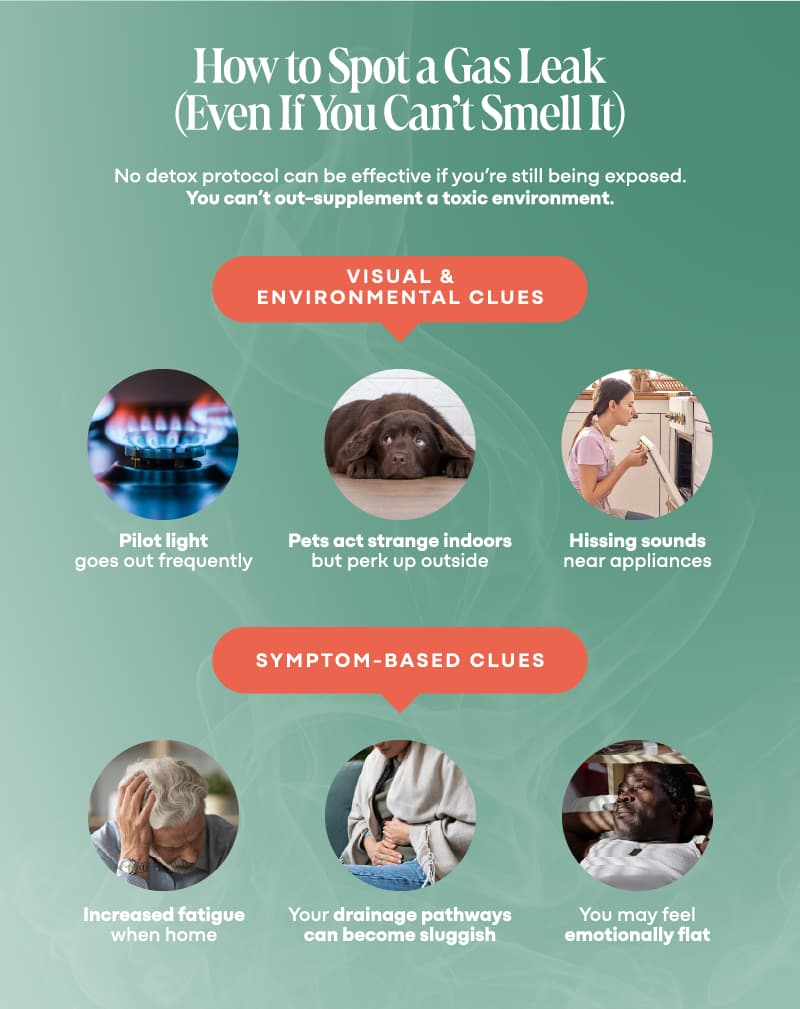
Mitochondrial Exhaustion = Chronic Fatigue
Your mitochondria — those tiny organelles inside your cells that make energy — are one of the first things to take a hit from gas exposure.
Toxins like nitrogen dioxide, formaldehyde, and VOCs interfere with mitochondrial function, creating more oxidative stress than your body can keep up with (9, 20, 21).
This leaves you in a constant energy deficit, like trying to run your life on a flickering phone battery.
Neurological & Mood Symptoms of A Gas Leak in Your Home
Many of these gas byproducts — especially VOCs like benzene and toluene — are neurotoxic (9, 20).
That means they kill your neurons and interfere with the way your nervous system sends and receives signals.
If your nervous system is already dysregulated (hi, mold illness survivors, trauma responders, and anyone who’s lived in chronic stress), these toxins make the dysregulation even worse.
You might notice your mind getting foggy or scattered, like you’re walking around with cotton between your ears.
Finishing a thought gets harder.
Words start disappearing mid-sentence.
You might find yourself snapping at people you love or feeling low-level dread without knowing why (10).
Maybe your head hurts more often than it used to — the kind of pulsing, behind-the-eyes headaches that make you want to hide from light and noise (10, 11, 14).
And when you try to sleep it off, your body doesn’t cooperate — you either can’t fall asleep or you wake up feeling like you never actually rested (10).\
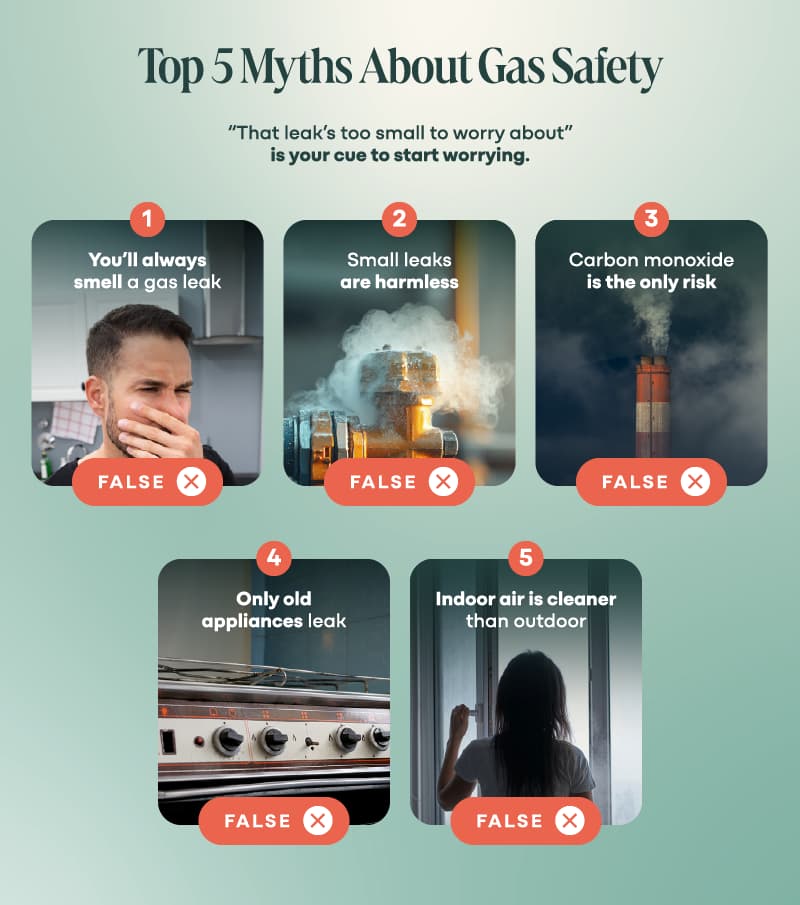
Cardiovascular Signs and Symptoms
The cardiovascular system is a preferred target of VOCs and other toxins (8, 9, 20, 24).
High blood pressure, arterial wall thickening, arterial stiffness, and plaque formation (9, 17).
Dizziness and irregular heartbeat (10).
Increased triglyceride and “bad” (LDL) cholesterol levels (9).
Leading to an increased risk of cardiac events and strokes (9, 17).
Respiratory & Sinus Symptoms
Bronchitis, asthma, and other respiratory issues develop as inhalation is the main route of exposure (1, 9, 10, 11, 13, 14, 19, 20, 21).
Your breathing may feel tight or shallow, like you just can’t get a full breath (1, 10, 11).
Or you might feel a weird need to sigh all the time (yes, this is real).
You may clear your throat constantly or wake up with dry sinuses and a scratchy voice.
That lingering post-nasal drip, the cough that won’t quite go away, the tension in your chest that gets worse after cooking dinner — it’s not just “seasonal.”

Hormonal Signs
The endocrine system is especially sensitive to chemical interference.
VOCs like benzene and formaldehyde are known endocrine disruptors — meaning they can mimic, block, or alter the normal function of hormones.
Over time, this can show up as estrogen dominance, low thyroid function, irregular cycles, adrenal burnout, or low testosterone.
You may feel emotionally flat, have zero motivation, gain weight despite eating clean, or experience sleep issues that don’t respond to any of your usual tools.
Digestive & Immune Symptoms
Every time your body is exposed to something foreign — like a combustion byproduct — your detox organs go to work.
Over time, this increases the burden on your liver, lymph, kidneys, and gut.
Your drainage pathways can become sluggish.
You may start reabsorbing toxins instead of eliminating them.
Nausea or vomiting anyone (10)?
You may experience more gut inflammation, sluggish motility, bloating, food reactions, or even the breakdown of the gut lining itself.
Meanwhile, your immune system is trying to keep up with constant chemical surveillance (9).
It gets overwhelmed and tired and is primed for allergic reactions (14, 19).
This is your body responding to a toxic burden it was never designed to carry.
The good news? You can start identifying the source and shifting your environment.

Suspect a Gas Leak? How to Tell Even If You Can’t Smell It
Here’s the thing most people don’t realize: You can have a gas leak and not smell a thing.
That “rotten egg” scent is a chemical called mercaptan that gas companies add to help people detect leaks.
But mercaptans don’t always do their job.
Some folks go nose-blind to them.
Others, especially those with mold illness or chronic Lyme, may have altered smell perception altogether.
And in many homes, the leaks are so slow and consistent that your body adjusts before your brain catches on.
So, if you’re thinking, “I don’t smell gas, so I must be fine,” — pause. That’s like assuming your roof isn’t leaking just because it’s not raining today.

Signs of a Natural Gas Leak
- Your pilot light keeps going out.
- There’s discoloration or scorch marks around your stove, furnace, or water heater.
- You hear a soft hissing sound near your appliances.
- Your gas bill spikes unexpectedly — especially if your usage hasn’t changed.
- You or your pets act strange at home but perk up when away. (Pets are often more sensitive than we are.)
- Your symptoms are worse at home, especially after cooking or using the heater.
- No treatment plan seems to really move the needle — or it helps briefly, then you crash again.
And here’s a HUGE red flag: If a technician tells you, “That leak’s too small to worry about,” your next move is to worry about it.
Or rather — to take it seriously and get a second opinion.
Small, chronic leaks are often dismissed as “harmless” because they’re under the legal reporting threshold.
But you don’t live at the EPA. (And the technician doesn’t live in your home.)
What to Do if You Suspect a Leak
If you suspect a leak, skip the scented candle test (yes, people really do that) and try this instead:
- Use a soap bubble test: Mix water with dish soap, brush it over the joints in your gas lines or around the stove connection. If it bubbles, there’s a leak. Old-school but effective.
- Invest in a gas leak detector: Look for ones that detect combustible gases, not just carbon monoxide. Bonus if it reads VOCs and methane.
- Check your gas meter: Turn off all gas appliances, then watch the meter. Is it still spinning? Something’s leaking.
- Bring in a building biologist or indoor air quality specialist, not just your gas company. A real air quality pro will use advanced detection tools and actually care about your health — not just legal compliance.
Detecting a gas leak isn’t about being paranoid — it’s about being proactive.
Because when the exposure is low and constant, the damage is subtle and cumulative.
And the sooner you can confirm the source, the sooner your body can start breathing (literally) easier.
In the next section, we’ll talk about what to do if you’ve been exposed — how to take smart, empowered steps to stop the exposure and support your recovery.

Natural Gas Poisoning: What to Do If You’ve Been Exposed
Most conventional approaches to gas exposure are designed to catch the acute stuff.
You know — the kind where you pass out on the floor and end up in the ER.
But that’s a tiny slice of the full picture.
What we’re talking about here is the slow, insidious kind of exposure — the kind that’s overlooked by doctors, dismissed by technicians, and lived with by thousands of people who can’t figure out why their body keeps crashing.
The treatment path is different — because you’re not recovering from a single event. You’re unburdening a system that’s been under low-grade attack for months or years.
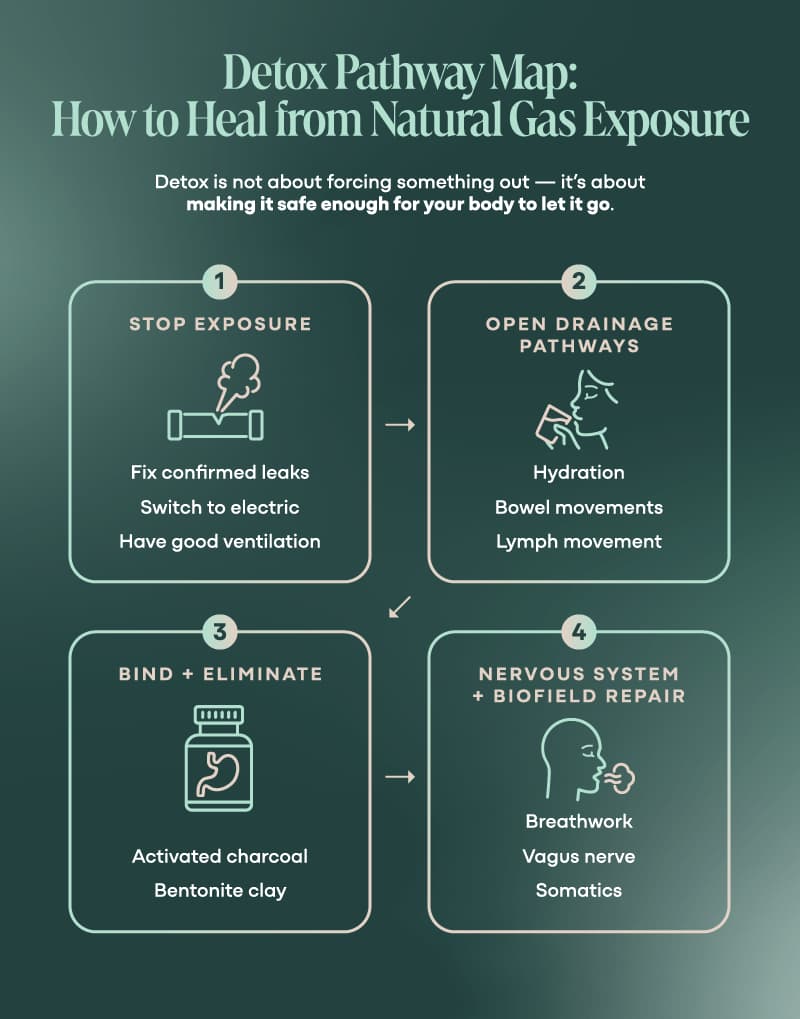
Stop the Ongoing Exposure to Natural Gas
Start by identifying the source.
- If you confirm a leak or discover poorly vented combustion appliances, get them fixed, capped, or replaced.
- Consider switching to electric appliances — especially your stove. (I know, I know — the gas flame is nostalgic, but nostalgia isn’t worth brain fog and chronic fatigue.)
- Make sure you have serious ventilation — not just a fan that recirculates air but one that vents outside.
- Open windows when you cook.
- Use portable air purifiers with carbon + HEPA filters to help remove lingering VOCs and combustion particles.
And while you’re at it?
Inspect your gas fireplaces, heaters, and water heaters. Those are sneaky sources of ongoing exposure.
Once you’ve reduced or eliminated the source of exposure, then your body can finally start shifting from survival mode into healing mode.
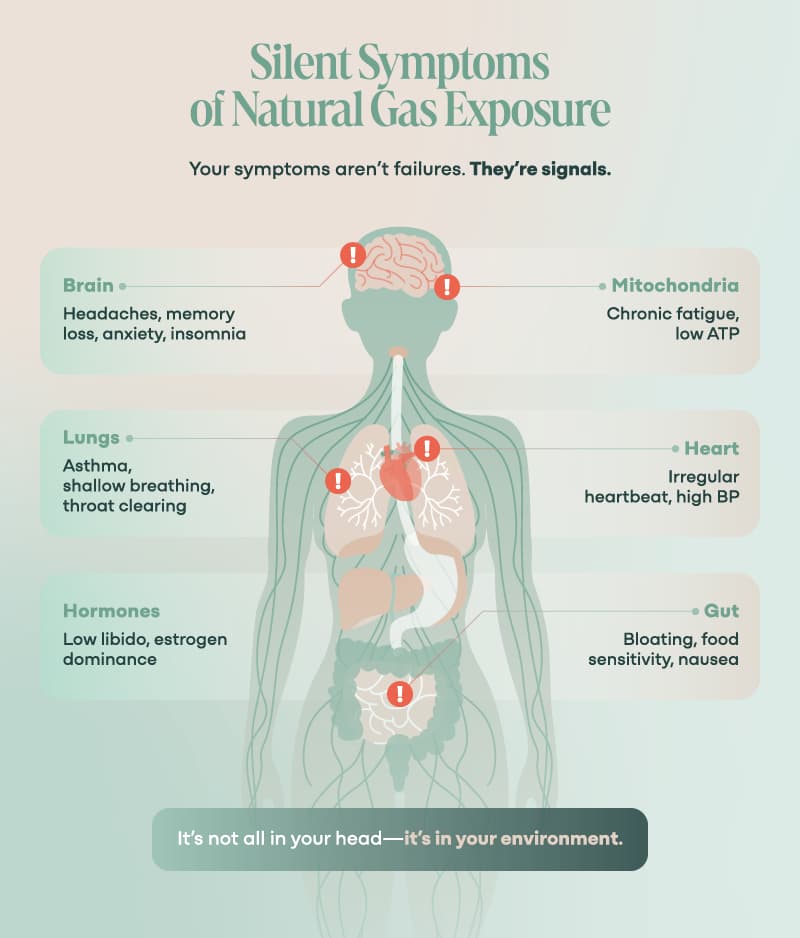
How to Detox from Gas-Related Chemicals (Without Making Yourself Worse)
Detox is about removing what’s in the way so your body can do what it already knows how to do.
Your body is brilliant. And once you stop the incoming toxins, it’s going to start releasing the backlog.
But if your drainage pathways are clogged — or you go too fast with the wrong tools — those toxins don’t leave.
They just recirculate.
That’s when people say things like “I tried detoxing and felt awful.”
Let’s walk through how to do this in a way that’s gentle, layered, and works.
Phase 1: Stop the Exposure (Again, for the people in the back)
Yes, we already said this — but it bears repeating.
No detox protocol will work if you’re still being exposed.
You can’t out-supplement a toxic environment.
Address your gas lines, appliances, and indoor air quality first.
Otherwise, you’re just rearranging deck chairs on the Titanic.
Ready to Detox with Confidence?
If you’re ready to go deeper and detox safely — with guidance that works — explore our Healing Labs. Get the clarity, direction, and support you need to feel your best.
Book A CallPhase 2: Open Your Drainage Pathways
Think of your drainage pathways as your body’s sewer system — colon, liver, kidneys, lymph, lungs, and skin. If these aren’t moving, detox gets stuck.
Start here:
- Hydration — distilled, mineralized water
- Bowel regularity — daily poops are non-negotiable
- Lymph support — dry brushing, rebounding, castor oil packs
- Gentle liver support — bitters, dandelion tea, or coffee enemas (if tolerated)
- Sweating — sauna, hot baths, or movement
- Deep breathing — oxygen is a detox tool too
This is the foundation. If you skip this step, nothing else you do will stick.
Phase 3: Bind, Neutralize, and Eliminate
Once your drainage is flowing, you can bring in gentle binders like activated charcoal or bentonite clay to latch onto toxins in the gut and carry them out.
Always start low and slow — you don’t need to “feel something” for it to be working.
More isn’t better. Effective is better.
You’ll also want to support Phase 1 and Phase 2 liver detox, which is where most gas-related toxins get processed. That means:
- Magnesium
- B-complex (especially B6, B9, B12)
- Milk thistle or artichoke leaf
- NAC or glutathione precursors (if tolerated)
Support mitochondria too — because detox takes energy.
- CoQ10
- PQQ
- L-carnitine
- D-ribose
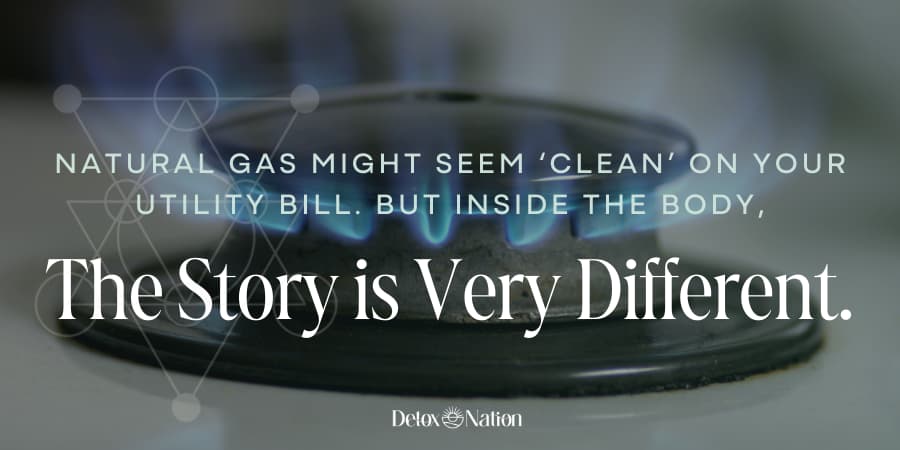
Phase 4: Nervous System & Biofield Repair
This step is usually left out of detox protocols — and it’s why so many of them fail.
If your nervous system is stuck in fight-or-flight, your body will not prioritize detox.
It’ll stay in survival mode, conserving resources and tightening up elimination.
To shift out of that loop, bring in daily nervous system tools:
- Vagus nerve activation: gargling, humming, cold water splashes
- Somatic movement or shaking
- Emotional release work (EFT, neural retraining, even just crying — yes, really)
- Gentle breathwork (4-7-8 is a good place to start)
This is where you reintroduce safety back into the system.
Where your body can finally say, “Okay. It’s safe to let go now.”
Final Thoughts: Your Home Should Heal You, Not Hurt You
If you’ve made it this far, you already know: this isn’t just about gas leaks.
It’s about how easy it is to feel like you’re the problem, when the real issue is something in your environment no one ever thought to check.
Here’s the shift: your symptoms aren’t failures. They’re signals.
They’re your body’s way of asking for help. Not punishment — just feedback.
Whether it’s replacing a gas stove, sealing a leak, upgrading your ventilation, or simply getting more intentional about supporting your drainage and nervous system — these small steps aren’t small at all.
They’re a declaration that your health matters more than convenience.
That your healing is worth protecting.
You don’t need to have it all figured out today. You just need to take the next step.
Let’s rebuild your resilience from the inside out.
Because your health is your birthright, and you are sacred and worthy of vibrant health.

